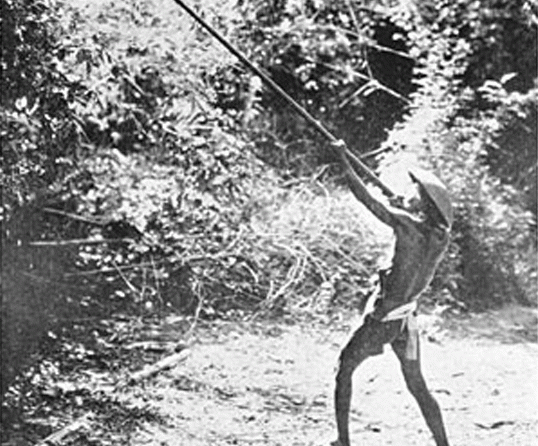The Filipino word for blowgun is “sumpit” or “sumpitan.” Used by the natives for both hunting and warfare, the blowgun is among the Philippine weapons described in details by Antonio Pigafetta, the chronicler of Ferdinand Magellan.
“Those people of Polaoan [Palawan] go naked as do the others: almost all of them cultivate their fields. They have blowpipes with thick wooden arrows more than one palmo long, with harpoon points, and other tipped with fishbones, and poisoned with an herb; while others are tipped with points of bamboo like harpoon and are poisoned.
At the end of the arrow they attach a little piece of softwood, instead of feathers. At the end of their blowpipes they fasten a bit of iron like a spearhead; and when they have shot all their arrows they fight with that (Pigafetta’s Account 1521 Part II, 1898, the Shaping of Philippine History Vol. 2 no. 17, October 1998).”
The spearhead attached to the blowpipe is obviously for close range fighting in the same manner that modern soldiers would use the bayonet when they have shot all their ammunitions. This type of blowgun, exactly as Pigafetta described nearly five centuries ago, still exists in Sabah, Malaysia today.
I mentioned this because Sabah was once part of Mindanao and even to this day, there is an unsettled issue regarding the ownership of the island between the Philippines and Malaysia.
Another document on pre-colonial Philippines that depicts the lethal quality of the blowgun is the Boxer Codex. The following excerpt from the translation by Carlos Quirino and Mauro Garcia published in The Philippine Journal of Science Vol.87, reads, “In some of these islands they use some blow-guns like those in Spain which they kill birds, and with which they shoot some very small arrows with very sharp iron points through the hole of the blow-gun, and the iron ends of these arrows are full of poison or herb. If they draw blood in the wound they make, [the victim] dies although [the wound] be small.”
It is the poison that made the darts shot through the blowpipe deadly. The pre-colonial Filipinos were experts in concocting a diverse variety of poisons (for more details on this subject please refer to my fmapulse article A Lost Art: Ancient Filipino Methods of Concocting Poisons) and blowgun projectiles were commonly smeared by the sap of the upas tree (scientific name: Antiaris toxicaria).
The latex of this plant was scientifically found to contain an extremely toxic cardiac glycoside, a component capable of increasing the force of contraction of the muscles of the heart.
The potency of this poison as well as the accuracy of the blowgun was described in the book The Former Philippines Thru Foreign Eyes By Fedor Jagor, Tomas de Comyn, Chas. Wilkes and Rudolf Virchow (1916), the authors wrote, “Among their other weapons is the sumpit, a hollow tube, through which they blow poisoned arrows.
The latter are of various kinds, and those used in war are dipped in the sap of what the natives term the “apo.” The effect of this poison is almost instantaneous, and destroys life in four or five minutes.
Those who have seen a wound given accidentally, describe the changes that the poison occasions as plainly perceptible in its progress. Before using the arrow, its poisoned point is dipped in lime-juice to quicken it. The range of the sumpit is from fifty to sixty yards. “
The material and manner of construction of the Filipino blowgun was mentioned by H. Wilfrid Walker, a fellow of the Royal Geographical Society in his book Wanderings Among South Sea Savages And in Borneo and the Philippines (London Witherby & Co. 1909). A portion of Walker’s book reads, “Many of the Filipinos are very good shots with their blowpipes, and Vic possessed one.
It was about nine feet in length, and possessed a sight made of a lump of wax at one end. Like the bows of the Negritos, it was made out of the trunk of a very beautiful fan-palm (Livistona sp.). Two pieces of the palm-wood are hollowed out and then stuck together in a wonderfully clever fashion, so that the joins barely show.
Vic was fairly good with it when shooting at birds a short distance away. His ammunition consisted of round clay pellets, which he fashioned to the right size by help of a hole in a small tin plate, which he always carried with him.”
The blowgun is among the easiest weapons to construct. Years back when I took deep interest in the weapon, I made a blowgun out of metal curtain rod and sharpened common nails (heads removed) as projectiles. For my darts’ fletching, I used cigarette filters with the paper peeled off.
It’s a perfect choice because it’s fluffy enough to create pressure in the blowpipe as air is blown into it, and attached to the dart it displays good aerodynamics. Without smearing poison on the darts, the only instance when you can inflict serious damage with a blowgun is when you shoot somebody in the eyes with it.
To the best of my knowledge, the only Filipino martial arts style today that employs the systematic use of the blowgun is the Pananandata system of Grandmaster Amante Mariñas. Mariñas is the author of Blowgun Techniques, a definitive book on all aspects of this unique ancient weapon.





















